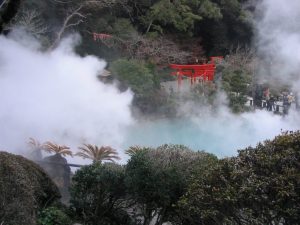 Thousands of natural hot springs (or onsen) dot Japan’s countryside, providing a haven for relaxation and contemplation for millions of people. For thousands of years, they have been an important part of the historical and social fabric of the country, and they are represented everywhere from famous ukioy-e woodblock prints from the 18th century to contemporary sitcoms.
Thousands of natural hot springs (or onsen) dot Japan’s countryside, providing a haven for relaxation and contemplation for millions of people. For thousands of years, they have been an important part of the historical and social fabric of the country, and they are represented everywhere from famous ukioy-e woodblock prints from the 18th century to contemporary sitcoms.
Today, however, they have the potential to be an important part of the transformation of Japan’s energy sector, with a power output equivalent to 23 gigawatts (GW) lying beneath the surface in the form of geothermal energy, the world’s third-largest store.
Geothermal power plants are not new to Japan. The first geothermal plant in the country opened in 1924 in Bepphu, with the steam also being used to heat houses and cook food in restaurants. However, it wasn’t until 1952 when Japan’s first commercial geothermal power station opened, in the city of Hachimantai in northern Japan. Built by Japan Metal & Chemicals and with turbines by Toshiba, the plant originally provided about 9.5 MW of power, about 40% of its output today, with the residual hot water used for agricultural applications.
But despite Japan’s technical and construction preeminence and its significant energy potential, there are only around twenty geothermal plants in Japan, with a total output capacity of around 535 MW, only 0.3% of the country’s total electricity generation. High upfront costs and rigorous regulatory processes are some of the reasons that the Wasabizawa plant, currently under construction in Akita prefecture, is the first large-scale geothermal project in about 20 years.
However, in the wake of the Fukushima nuclear disaster the Japanese government introduced new policies to accelerate geothermal power plant deployment. These included streamlined procedures for the approval of projects in national parks and, crucially, a new higher feed-in tariff (FIT) for small geothermal plants to more than one-and-a-half times of that of larger facilities. This made it profitable to build plants with an output below 7.5 MW, which do not require environmental impact assessments and can be built in around half the time of larger plants.
As a result, an important role of the small-scale geothermal plants built since 2012 has been to work closely with onsen operators, hotels and inns to prove that small-scale geothermal power generation can coexist with tourism facilities, without negatively impacting Japan’s natural beauty.
For Japan, already a global leader in renewable energy technologies and development, that is looking to reduce the risks associated with nuclear energy and the costs and air pollution associated with fossil fuel imports, domestic geothermal energy development can be a win-win scenario. Japan also has a lot to share in terms of its experience and innovations, and can take advantage of global platforms like the International Renewable Energy Agency and the Global Geothermal Alliance to continue to help other countries develop their own geothermal capacity.
Source: ”Unlocking Geothermal Potential in Japan Through Small-Scale Generation”, Irena
